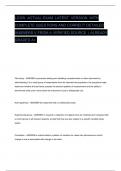LCSW ACTUAL EXAM LATEST VERSION WITH
COMPLETE QUESTIONS AND CORRECT DETAILED
ANSWERS V FROM A VERIFIED SOURCE | ALREADY
GRADED A+.
Pilot study - ANSWER-a procedure testing and validating a questionnaire or other instrument by
administering it to a small group of respondents from the intended test population; the procedure helps
determine whether the test items possess the desired qualities of measurement and the ability to
discriminate other prob- lems before the instrument is put to widespread use.
Null hypothesis - ANSWER-the statement that no relationship exists
Experimental group - ANSWER-in research a collection of subjects who are matched and compared with
a control group in all relevant respects, except that they are also subject to a specific variable being
tested.
Correlation - ANSWER-a mutual relation a pattern of variation be- tween two phenomena in which
change in one is associated with change in the other.
,Mean - ANSWER-the average value or measure of central ten- dency.
Literature review - ANSWER-the process of searching published work to find out what is known about a
research topic.
physical indicators of abuse - ANSWER-history of multiple injuries, history doesn'tfit, bruises on abdomen
and genital, linear bruises, bruises on neck, bitemarks burn head injuries and skull fractures.
Indicators of neglect - ANSWER-SELF stimulatory behavior, developmental delay, failure tothrive, poor
weight gain, thin extremities, hoarding or stealing food, chronictiredness and drowsiness, falling asleep in
school. Or attempts to comfortthemselves through masturbation. Awkward peer relationships.
Behavioral and emotional indicators of abuse - ANSWER-a child who is remote withdrawn, detached
andunresponsive, ambivalent, regressive behavior, frozen watchfulness, hyperactive behavior, lying,
stealing, fighting, angry outburst, anxiety, depression, dissociation episodes
Sign of sexual abuse - ANSWER-- marked change in child's behavior, bedwetting, soiling the bed, falling
asleep in class, highly sexualized behavior, gripping in public.
Child neglect - ANSWER-the failure of those responsible for the care of a minor to provide the resources
needed for healthy physical emotional and social development.
Child abuse - ANSWER-physical or emotional injury on a dependent minor through
,intentional beating uncontrolled corporal punishment persistent ridicule and degradation.
Physical indicators of abuse - ANSWER-history of multiple injuries, history doesn't fit, bruises
on abdomen, and genitals, linear bruises, bruises on neck, bite marks and burns, head injuries and skull
fractures.
Elder abuse - ANSWER-mistreatment of older people and relatively dependent people including physical
battering neglect financial or other exploitation and psychological harm
Physical abuse and neglect - ANSWER-bruises, welts, lacerations, punctures, burns, head
injuries, weight loss, untreated medical conditions and restraining the person,
Psychological abuse and neglect - ANSWER-sleep disturbance, change in eating patterns, unexplained
weight changes, depression and crying, low self-esteem, fearfulness and paranoia, confusion and
disorientation, apathy and agitation, social isolation and self-neglect.
Financial abuse - ANSWER-lack of food complaints of hunger, inability to pay bills,
over involvement of family members in financial affairs refusal to pay for services unexplained
withdrawals from bank account
crisis - ANSWER-overwhelming event that upsets one's psychological
equilibrium or baseline of functioning.
, Maturational crises - ANSWER-precipitated by normal stress during the course of life.
Example, marriage, child birth retirement
Situational crises - ANSWER-precipitated by sudden traumatic event. Example, death of
a loved one, loss of job and illness
Crises intervention - ANSWER-1-6 weeks' sessions during period of crisis, supportive focused therapy.
low risk - ANSWER-limited thoughts of harm, no plan or intent, low
risk factors present
low risk intervention - ANSWER-individual social support, individual coping mechanism,
referrals for clinical contacts, establish future events to look forward too, and reassess frequently
Moderate risks - ANSWER-ideation with limited plans and no intent
moderate risk interventions - ANSWER-explore alternative to violence, remove lethal means to
harm, decrease isolation, explore the options of meds.
High risks - ANSWER-specific plan with intent, access to lethal weapon, limited
support, impaired self-control.




